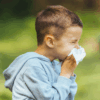If you’ve been watching the news lately, it will come as no surprise that our children are sick — and getting sicker. According to a 2011 study in Academic Pediatrics, 54% of American children are living with a chronic illness. Think about that…
ONE IN TWO CHILDREN TODAY ARE CHRONICALLY ILL.
What does it mean to have a chronic illness? According to the CDC, chronic illnesses are conditions which persist for at least 1 year and require ongoing medical attention.
In the pediatric population, this includes conditions like asthma, ADHD (attention deficit hyperactivity disorder), autism, OCD (obsessive compulsive disorder), PANS/PANDAS (autoimmune neurologic conditions), POTS (a condition affecting blood flow), and pediatric depression.
THE STATISTICS MAY SURPRISE YOU:
Autism: 1 in 45 children
ADHD: 1 in 10 children
Learning Disability: 1 in 6 children
Severe Mood Dysregulation (i.e., bipolar disorder): 1 in 30 children
Dyspraxia (impaired coordination and motor skills): 1 in 10 children
Pediatric Depression: 1 in 30 children
Obsessive Compulsive Disorder: 1 in 100 children
BUT IT’S NOT JUST CHILDREN.
It’s estimated that over 10% of women — as high as 1 in 8 — will develop invasive breast cancer. Likewise, the number of Americans suffering with multiple sclerosis has more than doubled since 1975 with an estimated 1 million adults affected in the United States alone.
Did you know 45% of Americans suffer from at least one chronic condition, and ⅔ of all deaths in the US can be attributed to chronic illness?
WHAT IS HAPPENING TO OUR CHILDREN, AND BY EXTENSION, TO OURSELVES?
In 2004, the Environmental Working Group (EWG) ran an investigation into toxic elements in infant cord blood. They isolated 287 pollutants. According to the report, “of these pollutants, 180 are known to cause cancer in humans or animals, 217 are toxic to the brain and the nervous system, and 208 have been shown to cause birth defects or abnormal development in animal tests.”
Likewise, of the infants tested, two separate labs found an average of 200 chemical pollutants in each sample — including mercury, polyaromatic hydrocarbons(PAHs), polybrominated dibenzo dioxin and furans (PCDD/F), perfluorinated chemicals (PFCs), organochlorine pesticides (OCs), polybrominated diphenyl ethers (PBDEs), and polychlorinated biphenyls (PCBs).
HOW ARE UNBORN INFANTS EXPOSED TO SO MANY TOXINS?
WE CONTACT HUNDREDS OF TOXIC ELEMENTS ON A DAILY BASIS — JUST BY LIVING:
😲 Pesticides
😲 Chemicals and GMOs in our foods
😲 Electromagnetic fields in our homes, cars, and offices
😲 Heavy metals polluting the air we breathe and the water we drink
😲 And more…
How many products do you use when you get ready for your day? You probably use soap, body wash, hair products, skincare, makeup, lotions, and others. A recent study found that these personal care products are exposing women to an estimated 168 chemicals every day.
But it’s not just what you put on your body. You’re exposed to chemicals and toxins just by breathing the air in your home:
🚩 Fire retardants in furniture
🚩 Phthalates and volatile organic compounds in rugs
🚩 Countless chemicals in the household cleaners we use every day
🚩 Hormone disrupting chemicals in food packaging and fragrance products
According to the EPA, indoor air quality in our homes and workplaces is often more polluted than outdoor air — even in highly industrialized, smog-filled cities. How much time do you spend inside your home or other buildings? The average American spends 90% of their life indoors, so most of us are breathing these toxins almost all day, every day.
WHAT DOES ALL THIS HAVE TO DO WITH DISEASES LIKE PANS/PANDAS?
Many chronic illnesses are multifactorial — meaning many factors influence the disease process. Age, genetics, stress, and environmental exposures all play a part. So a multifactorial disease cannot be pinned to a single cause.
MANY CHRONIC ILLNESSES ARE MULTIFACTORIAL. AND ONE OF THOSE CONTRIBUTING FACTORS IS TOXIC EXPOSURE.
Our bodies are equipped to deal with toxins — to a point. But our detoxification pathways can be overloaded. The volume of toxins we come into contact with on a daily basis can overwhelm our bodies. The combination and amount of toxins your body is dealing with is known as your total load.
But it’s not just chronic diseases that are multifactorial. I believe all disease outcomes — even our ability to recover from the common cold — are essentially multifactorial. We each have our own story. Our genetic makeup and environmental exposures make us each unique.
The story of your unique body is played out every day across your immune systems. This is why each person reacts differently to illness — from exposure to recovery.
Total load describes the sum of contributing factors involved in the cause and progression of disease. But it’s also involved in fostering a healthy and vital immune response. Essentially, when we look at total load, we examine which components in our lives are increasing stress, and which are fostering health.
SO, WHAT IS STRESS?
When people talk about stress, they’re usually referring to an anxious situation. But when we talk about the effects of stress on the body, it’s more specific. According to the Cleveland Clinic, stress can be defined as “a normal reaction the body has when changes occur, resulting in physical, emotional and intellectual responses.”
Stress isn’t necessarily bad. And our bodies are equipped to handle it. But stress does play a role in how we respond to illness and disease. We commonly look at factors such as age and genetics when we evaluate an immune response. But stress interacts with our genetic expression and affects our immune system as well.
When we talk about multifactorial diseases, we can break it down into the following equation:
GENES + ENVIRONMENT + INFECTIOUS FACTORS = DISEASE
When I see children in my practice who are diagnosed with PANS/PANDAS, we look at all the factors that contributed to the disease. Yes, PANDAS is triggered by a strep infection. But there is more to it than that.
I look at the child’s entire body story. And we work to eliminate the stressors and detoxify the total load. Working with multifactorial diseases requires a multifactorial approach.
And this is good news. While you can’t change your child’s genetics, you can change many things in their environment — including foods and toxins. These types of changes can make a huge difference in your child’s symptoms.
How I Can Help
✔ If you are wondering if your child might be suffering from either PANS or PANDAS but you’re not sure, take the PANS/PANDAS Symptom Assessment here. Although not a diagnostic tool, the PANS/PANDAS Symptom Assessment is a great way to gain clarity on a potential diagnosis and what to do about it.
✔ Sign-up for my email newsletter – you will receive tons of research and actionable information in this biweekly resource
✔ Download my eBook, Healing from PANS/PANDAS and Autoimmune Encephalitis: An At Home Guide to Reducing Brain Inflammation in Your Child and jumpstart your child’s healing
✔ Join the private Facebook community for parents of children with PANS/PANDAS and other neuroinflammatory brain conditions
✔ And finally, if you are interested in getting to the root of your child’s diagnosis and reversing symptoms for good, join me in my Foundations in Healing Jumpstart Program. The Foundations Program is a highly mentored, 8-week learning intensive for parents of children with inflammatory brain conditions like PANS/PANDAS, autism, ADHD, anxiety/depression, and Lyme. In addition to gaining access to my proven methodologies and proprietary knowledge, you will also be learning directly from me in an intimate group setting. For more on the Jumpstart Mentorship program, click here.
And remember, your child’s body is hardwired to heal, we just need to provide the tools. We are here for you!
For more information on the Foundations Program, click here.
To hear more about what former participants are saying, click here.







